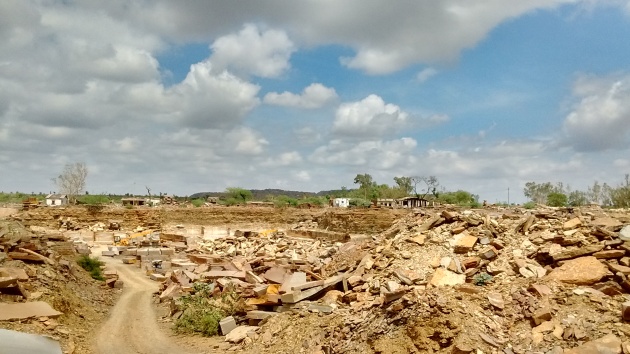
Living collectively
Being political Continue reading Living collectively

Being political Continue reading Living collectively

Men and women working late, stitching night dresses, in one of several “fabricator” units in a basement in Delhi Continue reading Working

Bijolia Khurd khaan. Sandstone quarries in Bhilwara, Rajasthan. Bijolia in Bhilwara and Dhabi in Boondi have some of the oldest and largest stone quarries on the Aravalli, India’s oldest mountain ranges, now eroded to stubs. Workers who live by the quarries and mines work with their hands, using chisels and hammers to cut stone into slabs, which contractors measure at the end of the work day. They earn Rs 3 for each foot of stone they cut, in eight hours, today, Subhash Mehr, Rajesh Yadav, Keshu Ram Jogi cut 70-80 feet stone at Sukhpura khaan. Continue reading Oldest mountain

“.the situations created by violence — particularly structural violence, by which I means pervasive social inequality that are ultimately backed by the threat of physical harm — invariably tend to create the kids of willful blindness we normally associate with bureaucratic procedures. To put it crudely: it is not so much that bureaucratic procedures are inherently stupid, or even that they tend to produce behaviour that they themselves define as stupid — though they do do that — but rather, that they are invariably ways of managing social situations that are already stupid because they are founded on structural violence. … Continue reading What we cannot say about bureaucracy

Hansda Sowvendra Shekhar’s novel, The Mysterious Ailment of Rupi Baskey, the story of a Santhali family over four generations, is remarkable for a deep and masterful observation of lives and descriptions of a tribal village – its tree groves, weekly markets, festivals, fights, and gatherings. The debut author, a doctor with the government of Jharkhand, lives in Pakur, along the state’s border with West Bengal. Once or twice, in descriptions when Rupi and her husband Sido visit doctors to seek cure for Rupi’s mysterious ailment, the writer’s professional knowledge seem perceptible in the narrative. At others, the descriptions of the … Continue reading A doctor tells stories

When I reached the control room, Upadhayayji (from Special Branch) was the first to have arrived. He put his phone down, ending a conversation with, “So, it was full of clothes, was it?” he chuckled. When I enquired what had happened, he said the bomb squad had been called in Lower Bazaar. “A black bag with wheels had been found”, he told me, “One of those bags with wheels, a trolley bag? All afternoon, there was alarm.” No one knew who had left the bag, and it could be a bomb. The bomb squad arrived, and found the bag stuffed … Continue reading Firayalal shaam


Was reporting in Latehar in west Jharkhand earlier this week. Crossing Koel on foot here and then crossing Chaupat river a few meters beyond this point is a routine on all trips to this part of Latehar as there are no bridges close by. But now in monsoon the river swells up and is in spate. Here Manoj Dutt, contributor to ANI from Latehar, gets by with a little help from mischievous friends as I follow the gang on foot. Continue reading Baarish mein nadi mein Latehar patrakaar

The parha jatra, a congregation of 5/7/12/21 villages which form a parha, has been celebrated in Oraon and Munda villages since long. But what was traditionally a religious congregation has also become a rallying point and an occasion for political leaders to assert clout. In 1967, Congress MLA Karamchand Bhagat supported and oganized the parha jatra in Bero for the first time. At the time, the police had imposed a curfew after six adivasis of the area were killed in police firing. Bhagat supported the village parhass efforts to organize the jatra to defy the curfew. Since Bhagat first supported … Continue reading Parha jatra, and politics

Fresh coaldust arrives from sponge iron plants. Kids run to find manganese scrap to sell. In Giridih, Jharkhand, today Continue reading Kids, Giridih